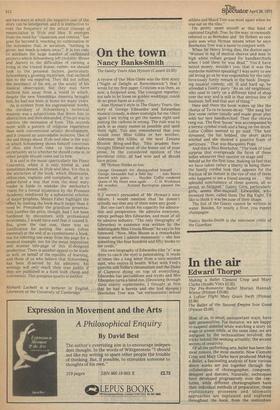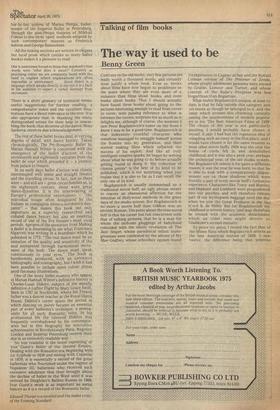In the air
Edward Thorpe
Making a Ballet Clement Crisp and Mary Clarke (Studio Vista £3.25)
The Pre-Romantic Ballet Marian Hannah Winter (Pitman £1.0.00)
A Loftier Flight Mary Grace Swift (Pitman £5.00)
The Ballet of the Second Empire Ivor Guest (Pitman £5.00)
Most of us, in small, unimportant ways, have split personalities. For instance, we are happy to suspend disbelief while watching a story on stage or screen while, at the same time, we are intrigued by the technicalities involved, the tricks behind the seeming actuality, the arcane secrets of creativity.
Of all the performing arts, ballet has been the most _remote, the most esoteric. Now Clement Crisp and Mary Clarke have produced Making a Ballet, a fascinating analysis of how various dance works are put together through the collaboration of choreographer, composer, designer and dancers. Naturally, techniques have developed progressively over the centuries, while different choreographers have their individual methods of preparation; these evolutionary processes and idiomatic approaches are explained and explored throughout the book, from the meticulous bar-by-bar system of Marius Petipa, balletmaster of the Imperial Ballet at Petersburg, through the post-Petipa theories of Mikhail Fokine to the more 'open' methods adopted by such contemporary masters as Frederick Ashton and George Balanchine.
All the linking sections are written in elegant but lucid prose which (unlike so many ballet books) makes it a pleasure to read:
One is sometimes forced to think that mankind's first words were 'what does it mean?' Certainly as practising critics we are constantly faced with the need to explain where explanations are often impossible or unnecessary . . . Since dance is a language which speaks directly to the eye it is a fault in the audience to expect a verbal message frorh movement.
There is a short glossary of technical terms, useful suggestions for further reading, a comprehensive index and the excellent illustrations have a direct relevance to the text. It is also appropriate that, in thanking the many distinguished artists for their help in assembling the book, that doyenne of the dance, Mme Sackova, receives due acknowledgement.
The rest of these ballet books deal, in varying degrees of detail, with dance history. Taken chronologically, The Pre-Romantic Ballet by Marian Hannah Winter is concerned with the emergence of the ballet d'action of the seventeenth and eighteenth centuries from the ballet de cour which preceded it — a journey from palace to theatre.
In its early days ballet d'action was closely intermingled with mime and straight theatre and the travelling circus. In fact, just as there were — and still are — great circus families so, in the eighteenth century, there were great dance-dynasties. It is the interweaving of Europe's professional entertainers — 'the individual troupe often designated by the Italians as compagnia mimica-acrobatica-danzante" — that makes this book not only important as a superbly researched and collated dance history but also an essential record of one of the live theatre's most vivid periods. Apropos of the quotation from Making a Ballet it is interesting to see what Francesco Algarotti was writing in a manifesto which he published in 1775: ,"The real dance must be an imitation of the quality and sensitivity of the soul interpreted through harmonious movement of the body. The dance must speak continuously to your eyes," The book is handsomely produced, with an extensive bibliography and iconography, but I wish it had been possible to include more colour plates
amid the many illustrations. •
One of the many ballet-masters who appear in Marian Hannah Winter's definitive history is Charles-Louis Didelot, subject of the equally definitive A Loftier Flight by Mary Grace Swift, Born in 1767 in Stockholm, where his French father was a dancer-teacher at the Royal Opera House, Didelot's career spans the period in which dancing on pointe became an essential part of every ballerina's technique, a prerequisite for all early Romantic roles. In his professional life the talented Didelot was frequently overshadowed by his contemporaries but in this biography his innovative achievements in Revolutionary Paris, Regency London and Imperial Petersburg receive their due in an eminently readable way. No less readable is the latest reprinting of Ivor Guest's Ballet of the Second Empire. Dealing with the Romantic era, beginning with La Sylphide in 1836 and ending with Coppelia in 1870, it is essentially a record of the great ballerinas who flourished under the regime of Napoleon III, ballerinas who received such excessive adulation that they brought about the decline of ballet in the West until it was revived by Diaghilev's Ballets Russes in 1909. Ivor Guest's work is as important as social history as it is a record of the Romantic ballet.
Edward Thorpe is a novelist and the ballet critic of the Evening Standard











































 Previous page
Previous page